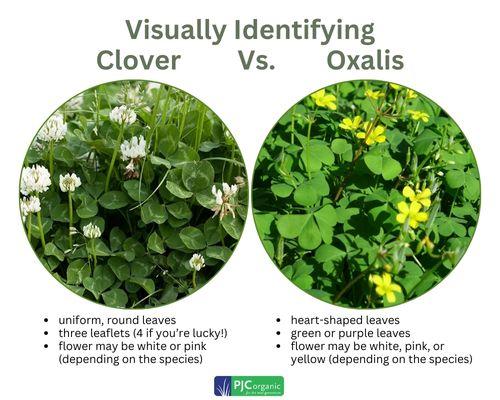As turf grass emerges from dormancy, clover often beats it out of the starting blocks. Clover is a cool-season perennial and is more likely to establish itself during a cool, wet spring before the turf grass starts growing. Here we’ll discuss the pros and cons of this plant, and how to control clover naturally.
When talking about clover, I should mention that many people mis-identify this plant and confuse it with Oxalis. The image below highlights that general visual difference between the two.

Benefits of Clover
Clover, despite its reputation as a weed, is appreciated by many. It offers several benefits that—depending on client visual expectations—make it a valuable component of lawns and landscapes. Historically, clover was included in grass seed blends and not until the 1950’s with the advent of broad leaf herbicides, like 2-4-D, was it thought of as a weed.
Clover is a beneficial plant because of its ability to obtain nitrogen from the atmosphere and ‘fix’ it in nodules on its roots. This Nitrogen fixing plant does indeed provide bio-available nitrogen to turf grass through its ability to convert atmospheric Nitrogen (N2) into Nitrates (NO3-) and Nitrites (NO2-) and Ammonium (NH4+). In turn, it enriches the soil and with the assistance of bacteria (Rhizobium) naturally fertilizes nearby plants. Additionally, it is highly effective at out-competing other invasive weeds, therefore reducing the need for herbicides. Just as important, clover provides food for pollinators.
Cons of Clover
While there are benefits to clover, notably this plant can be problematic in athletic fields. Too much clover can compromise the integrity of a playing surface. It doesn’t suit athletes playing sports because it doesn’t allow for consistent ball rolling speed and can be slippery when wet. Also, inconsistent field surfaces create difficulty for cleats to gain traction when changing direction. Despite its benefits—in some situations when out of control it can be problematic.
Lifecycle
Clover is a perennial. it grows from seed and expands from its low creeping branches. It produces seed from spring to fall but its most prominent season is late spring to early summer. Foliage dies back and goes dormant during winter months.
Environmental Conditions
Clover can be found in a wide variety of soil conditions, light conditions, and moisture conditions, however, it does best in moist soils. Clover will germinate in soil temperatures as low as 45° while cool season grass seed prefers soil temperatures in the 50° – 65° range allowing it to get a head start on the desirable grasses. It does well when there is not a lot of nitrogen available in the soil. Additionally, when turf grass is thin, light can reach the soil surface and encourage the clover to germinate.
Because clover seeds have a hard coat, they can survive in the soil for long periods of time until conditions are right to encourage their germination. The presence of large areas of clover in a lawn or athletic field can be an indicator that the area is not receiving adequate fertilization and it can often be found in areas with low soil pH.
Control Clover Naturally
Mitigating Clover by Adjusting Soil Chemistry
Low soil pH – Our cool season turf grass varieties grow best in soils with pH 6.5-6.8. Low soil pH can lock up nitrogen, making it harder for the grass plant to access necessary nutrients and making it easier for clover to outcompete the grass. Perform a a soil test to determine pH and the appropriate lime requirements to increase soil pH.
Mitigating Clover by Increasing Fertility
Low fertility is a common driver of clover growth. A balanced fertility program, delivering approximately 2-3 pounds of nitrogen per 1,000 square feet each season, is a good starting point. If results fall short, consider adding a fourth application or switching to a higher-nitrogen organic fertilizer. 3-4 applications of PJC Organic ProHealthy Turf fertilizers will improve soil health and fertility for a more robust lawn.
Mitigating Clover by Improving Organic Matter
Healthy levels of organic matter (OM) help buffer soil conditions and promote resilient turf. Increase OM by top-dressing, raising the height of cut during mowing, and maintaining deep, healthy roots that contribute to OM as they die off.
Mitigating Clover by Improving Soil Structure
PJC Organic ProHealthy Turf Charge-S3 and Boost+S3 both improve soil nutrient holding capacity. Charge-S3 does so by adding biochar and Boost+S3 add humates which improve soil organic matter and cation exchange capacity respectively.
Mitigating Clover Through Proper Watering
Avoid over watering. Water Deep and infrequently to encourage turf grass competition. Clover prefers moist conditions and typically dies off in particularly dry areas. Allow soils to dry out completely before running irrigation again.
Mitigating Clover with Overseeding
An aggressive over seeding program is key to thicken turf and crowd out clover. Aim to over-seed at least twice annually. In the spring, seed before May 15th. Seed between August 15th and September 15th in late summer or fall.
Seed Varieties
When over seeding in the spring, focus on grasses that germinate quickly, such as Perennial Rye Grass and Tall Fescue. These grasses, establish more rapidly in the cooler spring conditions and help create immediate ground coverage. in the fall, prioritize slower-germinating grasses—like Kentucky bluegrass—which benefit from the more extended establishment period and cooler, stable temperatures that encourage robust root development. selecting the right grass for the season ensures better results and improved turf density.
Proper Mowing Practices
Proper mowing is one of the most critical cultural practices for turf health. Maintain a higher mowing height throughout the growing season to improve stress resistance, enhance turf appearance, and reduce light penetration that encourages clover germination. All the while, return grass clippings to help boost organic matter.
Organic Turf Care Next Steps
To control clover naturally, start with addressing soil health and working proactively during the spring and fall to establish healthy turf. By improving soil fertility, increasing organic matter, and following proper cultural practices, landscapers can minimize clover naturally without the need for harsh chemicals.
If you’re ready to take the next step in implementing an organic turf care program, PJC can help. From soil testing to customized recommendations and organic fertilizer solutions, we make the process simpler and more effective. Contact PJC today for support in creating healthy, weed-resistant lawns and athletic fields.
—————————————
Note: Despite best efforts, if a situation warrants a rescue treatment use a least toxic herbicide and consider Fiesta®selective broad leaf weed killer. Fiesta uses a specially formulated iron solution (active ingredient: Iron HEDTA (FeHEDTA) 26.52%), that Does Not contain the synthetic weed chemicals 2,4-D or Dicamba. Fiesta iron-based weed killer is registered with the EPA and requires a pesticide license to apply. Contact PJC for pricing.
